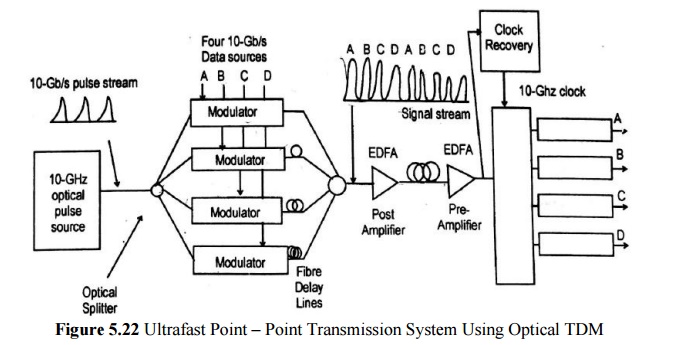Chapter: Optical Communication and Networking : Optical Networks
Ultra High Capacity Networks
ULTRA HIGH CAPACITY NETWORKS
Advance of optical communication systems has provide channels with enormous bandwidth at least 25THz and dense WDM technology, ultrafast optical TDM.
To using dense WDM techniques to increase the capacity of long-haul transmission link and ultrafast optical TDM schemes.
These are particularly attractive in LAN or MANs
TDM Schemes To Shared-Media Local Neteorks Have Two Methods:
(1) Bit-interleaved TDM.
(2) Time-slotted TDM.
1. Ultra High Capacity WDM Networks
Two popular approaches are used to achieve increased capacity.
(a) to widen the spectral bandwidth of EDFAs from 30 to 80 nm, by using broadening techniques.
Increasing the capacity of a WDM link is to improve the spectral efficiency of the WDM signals.
Most of the demonstrations use a rate of 20 Gb/s for each individual wavelength to avoid non-linear effects.
Examples are,
(1) A 50-channel WDM system operating at an aggregated 1-Tb/s rate over a 600 km link.
(2) A 132-channel WDM system operating at an aggregated 2.6 Tb/s rate over a 120-km/link.
2. Bit-Interleaved Optical TDM

Repetition rate typically ranges from 2.5 to 10 Gb/S, which corresponds to the bit rate of the electric data tributaries feeding the system.
An optical splitter divides the pulse train into N separate streams.
The pulse streams is 10 Gb/S and N=4, each of these channels is then individually modulated by an electrical tributary data source at a bit rate B.
The modulated outputs are delayed individually by different fractions of the clock period, and are then interleaved through an optical combiner to produce an aggregate bitrate of NXB.
Optical post amplifier and preamplifier are generally included in the link to compenstate for splitting and attenuation loss.
At the receiving end, the aggregate pulse stream is demultiplexed into the original N independent data channels for further signal processing.
A clock-recovery mechanism operating at the base bit rate B is required at the receiver to drive and synchronize the demultiplexer.
Related Topics